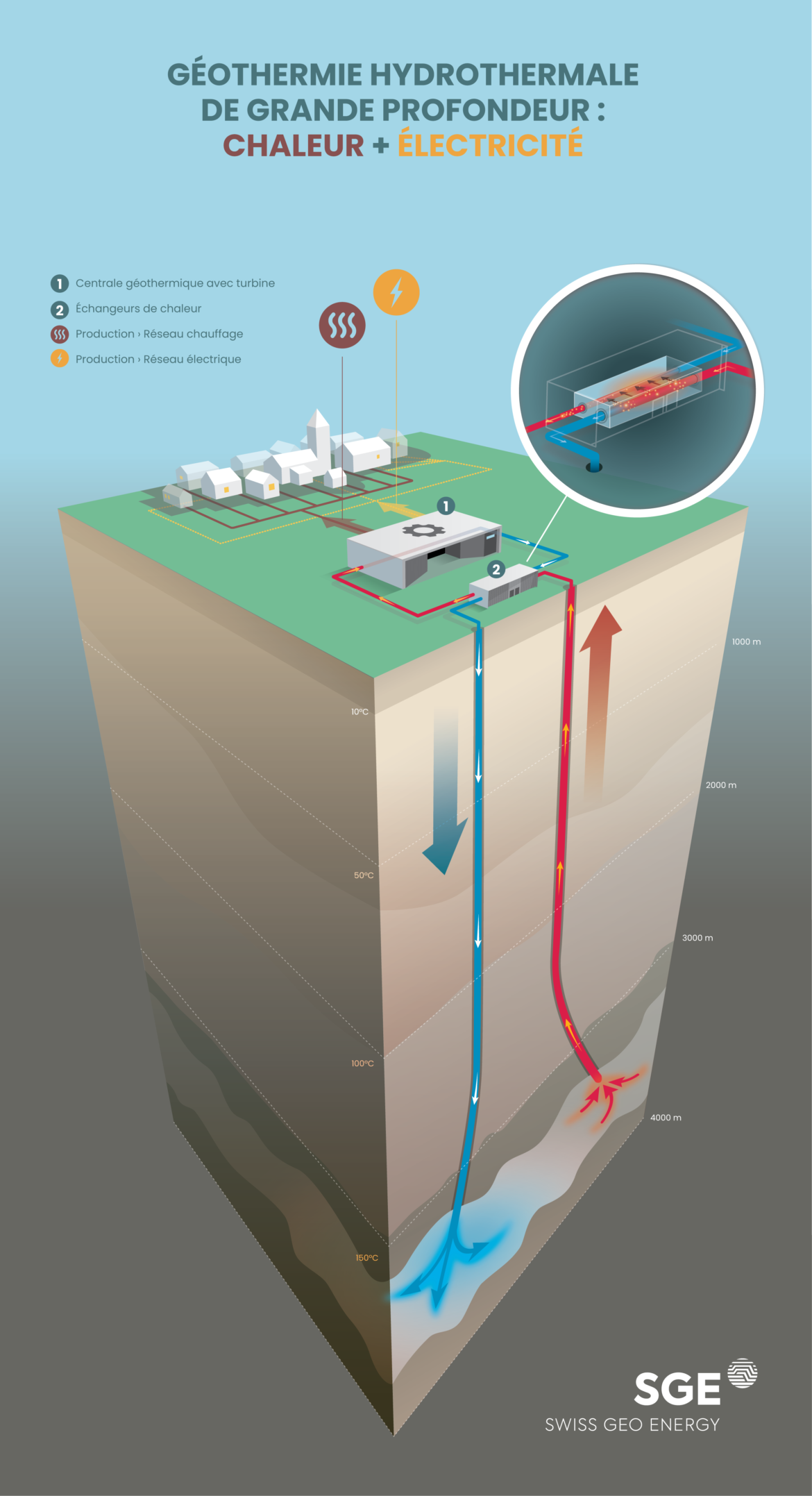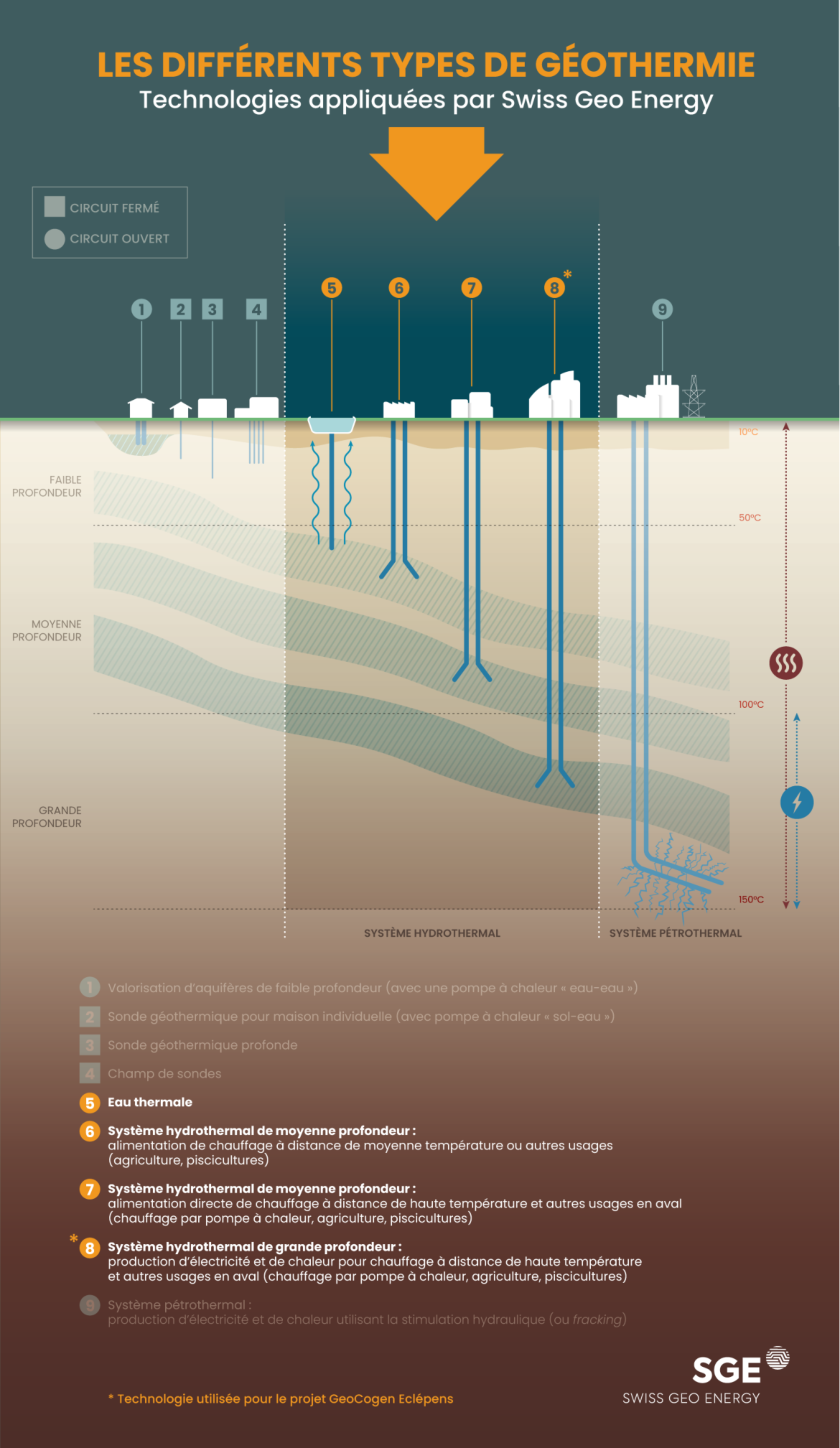The energy produced by a geothermal power plant, in the form of heat and/or electricity, is competitive with the costs of fossil fuels and other renewable energy sources.
Geothermal energy in brief
- Geothermal energy : is a renewable energy using residual and natural subsurface’s heat
- Origin of geothermal heat : Natural processes within the earth’s crust and heat exchange via groundwater circulation
- Uses : Hot water from the geothermal reservoir is pumped to the surface, and part of its heat is recovered via a heat exchanger. This same water is reinjected into the subsoil through a second well in order to conserve the resource and allow its regeneration. The extracted heat is used to supply a district heating network and, if the temperature exceeds 110°C, to produce electricity via an ORC (Organic Rankine Cycle) turbine
- Advantages : renewable energy, constant availability and low environmental impact
What is geothermal energy ?
Geothermal energy is a type of renewable energy that harnesses the inherent heat within the Earth’s crust. This heat energy is naturally created, located deep within the Earth’s crust, is transported via the circulation of groundwater within permeable systems such as porous layers or natural breaks.
This heat energy is used in the generation of energy, commonly in the forms of direct heat and/or electricity. The method employed involves capturing and harnessing the heat trapped in the Earth’s hot water layers. At relatively shallow depths, the heat is typically harvested through geothermal probes paired with surface heat pumps. However, at greater depths, the heat is directly extracted and used for powering district heating networks or for generating electricity, given the temperature is above 110 degrees Celsius.
One of the standout benefits of geothermal energy is its continual availability, coupled with its minimal environmental impact and small physical footprint. Serving as a reliable and steady source of energy, it is an invaluable component of district heating networks. It allows a significant reduction in the use of fossil fuels, which in turn substantially curbs greenhouse gas emissions. This contributes to a significant boost in sustainable, locally sourced energy production.
Geothermal system: open or closed loop?
Open or closed loop systems describe how water or heat transfer fluid circulates through the geothermal power plant system to capture and transfer heat. Swiss Geo Energy has chosen to focus on open loop geothermal systems.
Open-loop geothermal systems are generally used for deeper geothermal resources and higher temperature levels, while closed-loop systems are commonly used for shallow geothermal applications to power ground source heat pumps (“ground-to-water heat pumps”).
Open loop
- Groundwater is extracted directly from the ground through a production well.
- Heat is extracted from this water for the production of heat and/or electricity.
- The cooled water is reinjected into the subsoil via a separate well to avoid depletion and cooling of the resource.
- The water comes into direct contact with the geological formations and heat exchange takes place directly between the groundwater and the bedrock.
Closed loop
- A heat transfer fluid (water or water/glycol mixture) circulates in a network of buried pipes or vertical geothermal probes without being in direct contact with the geological formations.
- Heat is transferred from the ground to the heat transfer fluid by conduction and then the fluid is pumped to the surface to supply a heating or cooling system.
- The cooled heat transfer fluid returns to the pipe network to begin the heat capture process again.
- The circuit is hermetically sealed to prevent groundwater contamination and reduce energy losses.
Swiss Geo Energy : the choice of hydrothermal systems
The technology planned for Swiss Geo Energy’s geothermal projects is called hydrothermal. This means that we look for natural geological structures at depth and identify those that are most favourable for the circulation of hot water. We then pump this hot water, extract some of the thermal load and reinject it. We avoid the use of hydraulic stimulation (or fracking) to avoid the risk of induced seismicity. Hydrothermal technology has been successfully applied for decades in the Paris area and for more than 15 years in the Munich area without producing any seismic or environmental concerns.
The renunciation of hydraulic stimulation increases the need for precise imaging and characterisation of the geological structures of the subsoil. This need is the very reason for the 3D geophysical measurement campaign planned for this autumn as part of the GeoCogen Eclépens project.
With our ambition to contribute to the Confederation’s energy strategy, our approach is based on transparency and dialogue with all stakeholders. All our activities are based on the strictest safety protocols and are approved upstream by the State of Vaud. Technical support from the State of Vaud and SFOE experts is provided before, during and after the measurement campaign itself.

